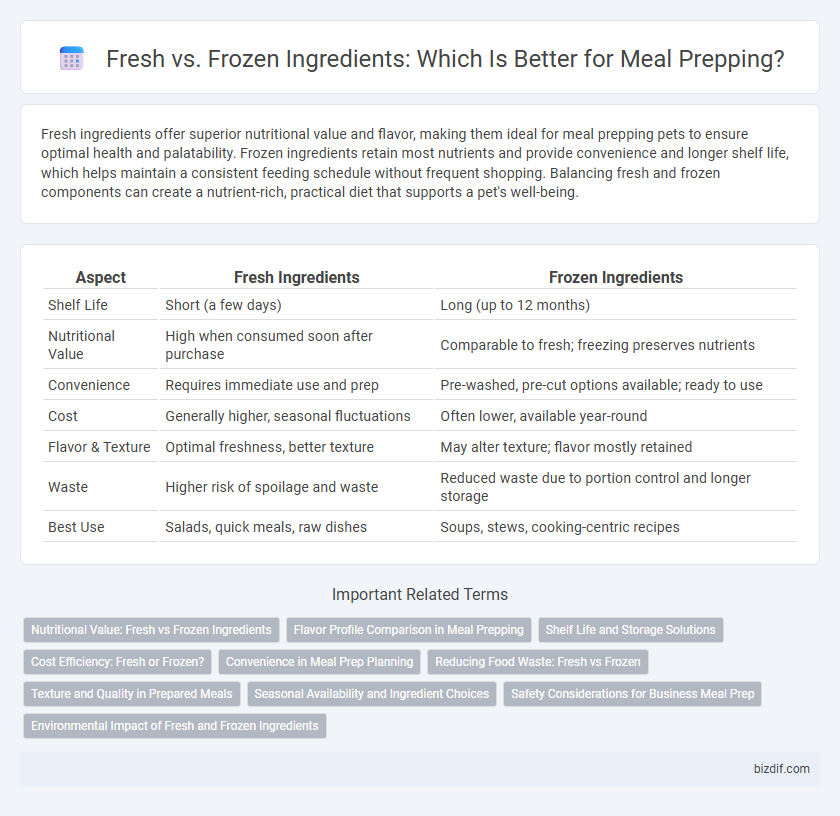Fresh ingredients offer superior nutritional value and flavor, making them ideal for meal prepping pets to ensure optimal health and palatability. Frozen ingredients retain most nutrients and provide convenience and longer shelf life, which helps maintain a consistent feeding schedule without frequent shopping. Balancing fresh and frozen components can create a nutrient-rich, practical diet that supports a pet's well-being.
Table of Comparison
| Aspect | Fresh Ingredients | Frozen Ingredients |
|---|---|---|
| Shelf Life | Short (a few days) | Long (up to 12 months) |
| Nutritional Value | High when consumed soon after purchase | Comparable to fresh; freezing preserves nutrients |
| Convenience | Requires immediate use and prep | Pre-washed, pre-cut options available; ready to use |
| Cost | Generally higher, seasonal fluctuations | Often lower, available year-round |
| Flavor & Texture | Optimal freshness, better texture | May alter texture; flavor mostly retained |
| Waste | Higher risk of spoilage and waste | Reduced waste due to portion control and longer storage |
| Best Use | Salads, quick meals, raw dishes | Soups, stews, cooking-centric recipes |
Nutritional Value: Fresh vs Frozen Ingredients
Fresh ingredients often retain higher levels of certain vitamins, such as vitamin C and B-complex, due to minimal processing and shorter storage times. Frozen ingredients are typically flash-frozen shortly after harvest, preserving most nutrients, including fiber and antioxidants, with minimal loss compared to fresh, especially when fresh produce has been stored for extended periods. Both fresh and frozen options can offer high nutritional value, but nutrient retention depends heavily on the specific ingredient and handling methods.
Flavor Profile Comparison in Meal Prepping
Fresh ingredients in meal prepping typically offer a more vibrant and natural flavor profile, enhancing the overall taste and texture of dishes. Frozen ingredients retain most of their nutritional value but can sometimes experience slight changes in flavor and texture due to the freezing process. Selecting between fresh and frozen ingredients depends on recipe requirements and desired flavor intensity in meal preparation.
Shelf Life and Storage Solutions
Fresh ingredients offer optimal flavor and nutrient retention but have a limited shelf life, typically lasting 3 to 7 days when stored properly in the refrigerator. Frozen ingredients extend shelf life significantly, often preserving edibility and nutritional value for several months, making them ideal for long-term meal prepping. Effective storage solutions such as airtight containers and vacuum sealing enhance the freshness of both fresh and frozen ingredients by minimizing exposure to air and moisture.
Cost Efficiency: Fresh or Frozen?
Frozen ingredients often provide greater cost efficiency due to longer shelf life and reduced waste compared to fresh ingredients that spoil quickly. Bulk purchasing of frozen produce can lower overall meal prep expenses, making it ideal for budget-conscious planning. While fresh ingredients may offer superior flavor and texture, frozen options balance quality with affordability for consistent meal preparation.
Convenience in Meal Prep Planning
Fresh ingredients offer vibrant flavors and optimal nutrient retention, enhancing meal quality but often require immediate use and more preparation time. Frozen ingredients provide extended shelf life and consistent availability, simplifying meal prep scheduling and reducing food waste. Prioritizing frozen options can streamline planning by enabling bulk purchases and flexible storage without compromising essential nutrients.
Reducing Food Waste: Fresh vs Frozen
Using fresh ingredients in meal prepping often leads to quicker spoilage, increasing the risk of food waste if not consumed promptly. Frozen ingredients retain nutrients longer and can be portioned precisely, reducing excess and minimizing waste over time. Choosing frozen over fresh can optimize meal planning efficiency by extending shelf life and preventing unnecessary disposal.
Texture and Quality in Prepared Meals
Fresh ingredients in meal prepping typically retain superior texture and quality, offering vibrant flavors and crispness that enhance the overall eating experience. Frozen ingredients, while convenient and nutrient-preserving, can suffer from moisture loss and texture softening during freezing and thawing processes. Selecting fresh produce and proteins ensures meals maintain optimal taste and mouthfeel, crucial for high-quality prepared dishes.
Seasonal Availability and Ingredient Choices
Seasonal availability significantly influences the choice between fresh and frozen ingredients in meal prepping, as fresh produce is often sourced at peak ripeness, enhancing flavor and nutritional value. Frozen ingredients provide consistent access to out-of-season items, reducing food waste and extending ingredient variety throughout the year. Balancing fresh and frozen options allows for greater flexibility in meal planning while maintaining the quality and diversity of nutrient-rich ingredients.
Safety Considerations for Business Meal Prep
Ensuring food safety in business meal prep requires strict adherence to temperature control and proper storage for both fresh and frozen ingredients to prevent bacterial contamination. Fresh ingredients must be handled with care to avoid cross-contamination and spoilage, while frozen ingredients should remain consistently frozen until preparation to maintain quality and safety standards. Implementing rigorous hygiene protocols and regular quality checks ensures compliance with food safety regulations, reducing health risks for consumers.
Environmental Impact of Fresh and Frozen Ingredients
Fresh ingredients often require more frequent transportation and refrigeration, leading to higher carbon emissions compared to frozen ingredients, which can be stored longer and transported in bulk more efficiently. Frozen ingredients help reduce food waste by extending shelf life, minimizing the environmental impact associated with spoilage in fresh produce. Choosing frozen options supports lower energy consumption during transit and storage, making them a more sustainable choice in meal prepping.
Fresh Ingredients vs Frozen Ingredients Infographic

 bizdif.com
bizdif.com